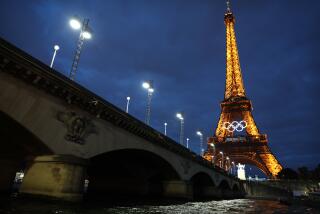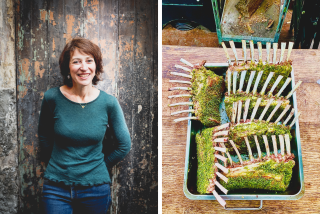Sweetener Ban Lifted : French Diets Switching to Lean Cuisine
- Share via
PARIS — For the past several weeks, billboards all over Paris have featured a superbly fit young woman wearing only a bikini bottom and an ecstatic expression. The billboards urge passers-by to “discover the pleasure of one calorie.”
Except perhaps for the model’s partial nudity, the billboards for the diet Coca-Cola would be no big deal in the United States or most other Western countries accustomed to low-calorie products.
Here, however, their sudden appearance this month, just as Parisians were flocking back from their traditional summer vacations, was a kind of culinary milestone.
Since 1902, a French law aimed at protecting sugar beet farmers had prohibited the sale outside of pharmacies of sugar substitutes, the kind used in the hundreds of artificially sweetened products in the United States.
Sold Like Medicines
Saccharine, aspartame and other sugar substitutes were packaged like medicines and sold over the drugstore counter in a way that made customers feel they were buying a dangerous controlled substance.
Late last year, the law was finally repealed, causing great relief in the French packaged food industry, which feared that it would find itself hopelessly behind its neighbors when European trade barriers are dissolved into a single market in 1992.
Coca-Cola France, which sells the artificially sweetened Coca-Cola Light featured on the billboards, took out celebratory full-page ads in French newspapers, superimposed over a photograph of Parliament in session.
After the law was repealed, it took the American company and its several French competitors months to get their artificially sweetened products on the market. The appearance of the billboards signaled the beginning of the battle for the previously unexploited French diet drink market, which in the United States now accounts for nearly 30% of the $40-billion-a-year soft drink industry.
Last Barrier Falls
But it also symbolized the elimination of the last barrier between France--home and temple of la vie gastronomique-- and the expanding world of sugar-free, lean cuisines that are a central part of life in the rest of the West.
Today in French grocery stores, displayed among such traditional French food products as fresh cream, blood sausages and hopelessly high calorie pates encased in fat, is an array of new “light” products, ranging from low-cal “drinkable” yogurts to a series of frozen, microwave-ready meals under 300 calories each.
While the change might distress French food purists, according to sociologist Claude Fischler, an expert on food and eating habits for the Center for National Scientific Research in Paris, it is only a matter of France catching up with changing food habits experienced “basically in all developed countries.”
“Even in France,” said Fischler, “there has been a gradual disintegration of traditional patterns of eating in which you had elaborate meals consumed in a greatly defined context of rules.”
The same sociological conditions that led to convenience foods in the United States--smaller households, working women, high-pressure professional jobs--exist in France. So does the desire among young, upwardly mobile professionals to stay fit and trim.
Etre en forme --”to be in shape”--is the current French expression that captures the spirit of the prevailing attitude. At least one of the new diet products, an orange-based fruit drink, Oasis Forme, has incorporated the language in its name.
‘Concern for Fitness’
In fact, the main advertising emphasis in France’s low-calorie market is more on fitness and health than it is on losing weight or dieting.
“The concern for fitness and lean-ness,” announced an advertising release from a subsidiary of the Swiss-based Nestle SA that markets a line of low-calorie frozen meals under the name Cuisine Legere (Light Cuisine). “Hiking, jogging, aerobics, gym-workouts and weight-training are becoming part of our environment.”
‘Dieting” has a completely different, much more severe, cultural connotation in France.
“It means you are sick and your doctor has prescribed a minimum amount of food--white rice and water for example,” said Cyriac De Salaberry, spokesman for Coca-Cola France.
“We don’t use the word ‘diet’ here because it is a very hard word,” said Wendy Dryden, product manager for Cuisine Legere. “The image of dieting is one of deprivation--very negative.”
As a result, all the French ad campaigns emphasize fitness, health and pleasure.
This still causes some problems. Coca-Cola Light, the European brand name for Diet Coke, urges customers to “discover the pleasure of one calorie.”
Hazy About Calories
But few French, according to De Salaberry, know what a calorie is. The concept of restricting and counting calories as a method of losing weight is still alien to the French culture. As a result, the advertising campaign is conducted as though something--the one calorie--has actually been added to the product rather than something--sugar--taken away.
The “calorie” thus takes on the connotation of some kind of pleasurable additive, like a truffle or a new spice, which is there to enhance life.
Food sociologist Fischler is developing a complicated theory for the French “pleasure” approach versus the American “diet” emphasis. He said it will require an examination of the more ornate Roman Catholic traditions that dominate France in contrast to the more ascetic Protestant “Calvinist” traditions found in the United States.
Oddly enough, the new consumer trend to lighter, simpler, healthier food in France had already been anticipated by many of the country’s greatest chefs. Beginning in the early 1970s, chef Michel Guerard began offering cuisine-minceur (lean cuisine) meals at his famed Bordeaux restaurant Les Pres D’Eugenie.
Whipped Garlic Cream
Guerard, whose restaurant enjoys the highest rating--three stars--in the Michelin Guide, hosts special low-calorie retreats during which guests can enjoy such specialties as smoked cod in light whipped garlic cream, young rabbit in bouillon and iced fruit.
The servings are small. Ingredients are fresh and simply cooked. The emphasis is on the presentation. Less fat, lighter sauces, overall lightness--in short, it is the nouvelle cuisine that has been the rage for years here and elsewhere in the world where French cooking reigns.
Another key factor that led to the breakthrough in low-cal foods in the country that created such courses as pig’s foot in bearnaise sauce and mousse au chocolat was the remarkable, relatively recent acceptance of frozen foods.
“Fifteen years ago, frozen food was considered only slightly better than food in cans,” Fischler said. “People would go through garbage containers outside restaurants and create a scandal if they found evidence of frozen products. Now ‘frozen’ means fresher than fresh.”
In Paris, large frozen food shops are now found next to all the main open-air markets. The range of frozen foods available rivals that found in the United States. Included are a whole gamut of low-cal dinners and courses including frozen Burgundy snails, “American fried chicken” that is accompanied by sweet corn and a dollop of frozen ketchup, toast with goat cheese and frozen frog thighs.
The final hurdle in low-cal France was the 1902 law prohibiting the sale of sugar substitutes outside of pharmacies.
Coca-Cola France, for one, is hoping to cash in on the new market.
Despite strenuous marketing campaigns, neither Coca-Cola nor any other soft drink company has ever made a strong inroad into the French market with its regular product.
According to the Beverage World International, an industry trade magazine, the per capita annual consumption of soft drinks in France is 13.2 gallons compared to 42.8 gallons in the United States. The French statistic is also deceptive since it also includes fruit juices and a carbonated lemon drink that is used as a mix with beer in panache, a popular bar drink.
According to De Salaberry, the annual per capita consumption of Coca-Cola in France is only five liters, compared to 25 liters in neighboring Belgium, 20 liters in West Germany and more than 10 liters in Spain and Italy.
“In France, the choice of drinks available to the customer is very different,” De Salaberry said. “With so many wines, beers and mineral waters available, there was not a huge space left for soft drinks.”
When Coca-Cola first came to France after World War II, it was greeted with open hostility. In Bordeaux, French unionists overturned Coke trucks. “They thought it was a new Beaujolais from Texas, coming in to take over business,” De Salaberry said. In 1950, a French legislator drafted a law banning the sale of the soft drink in France.
The American company fought back bravely. To appease the leftist unionists, it became the official soft drink of the annual Communist Fete de l’Humanite held outside Paris. It introduced the first refrigerators in French cafes in hopes that the cafe owners would use them to chill their product.
In recent years, the company has enjoyed steady growth as fast food franchises, once shunned by the French, have become solidly established in the major cities. In Paris alone there are more than 20 McDonald’s franchises. Recently, the Burger King chain mounted a large mobile advertising campaign to welcome the French back from their annual holidays.
“ Descendez un Texan (Down a Texan),” the company urged from billboards mounted on a fleet of paneled trucks. The billboards depicted a giant bacon hamburger sold in the franchises.
Coca-Cola and the other French soft-drink firms competing for the low-cal market are hoping the new French preoccupation with fitness will vault their products into the national cultural mainstream. Already, they point out, the consumption of wine in France is declining steadily, partly as a result of the health factor.
Barrington Hill is creative director for the American McCann-Erickson advertising agency that handles the Coca-Cola account here.
He is careful not to exaggerate the potential in France:
“This is really not a soft-drink culture. It is still on the fringe.”
Still, he said the prospects for selling diet drinks are better in France than they were in Japan, where he directed the launching of Coca-Cola Light before coming to Paris.
“In France,” he said, “the market is not really people who are fat. It is people who are worried about getting fat. After all, this is a country that has ‘thinning creams’ and that created spas. In Japan, no one was fat and no one was worried about it.”
More to Read
Eat your way across L.A.
Get our weekly Tasting Notes newsletter for reviews, news and more.
You may occasionally receive promotional content from the Los Angeles Times.










